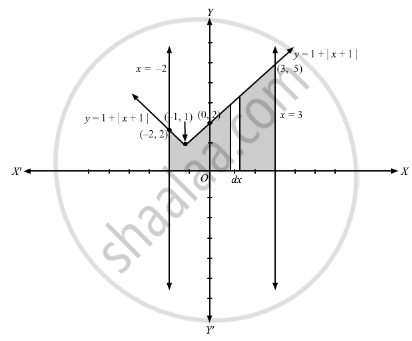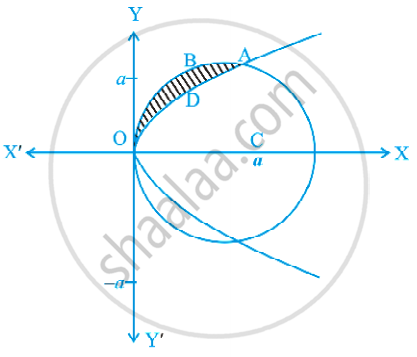Advertisements
Advertisements
प्रश्न
Using integration, find the area of the region bounded by the following curves, after making a rough sketch: y = 1 + | x + 1 |, x = −2, x = 3, y = 0.
उत्तर

We have,
y = 1 + | x + 1 | intersect x = − 2 and at ( −2, 2) and x = 3 at (3, 5).
And y = 0 is the x-axis.
The shaded region is our required region whose area has to be found
\[y = 1 + \left| x + 1 \right|\]
\[ = \begin{cases}1 - \left( x + 1 \right) &x < - 1\\1 + \left( x + 1 \right)& x \geq 1\end{cases}\]
\[ = \begin{cases} - x x& < - 1\\x + 2& x \geq 1\end{cases}\]
Let the required area be A. Since limits on x are given, we use horizontal strips to find the area:
\[A = \int_{- 2}^3 \left| y \right| d x\]
\[ = \int_{- 2}^{- 1} \left| y \right| d x + \int_{- 1}^3 \left| y \right| d x\]
\[ = \int_{- 2}^{- 1} - x d x + \int_{- 1}^3 \left( x + 2 \right) d x\]
\[ = - \left[ \frac{x^2}{2} \right]_{- 2}^{- 1} + \left[ \frac{x^2}{2} + 2x \right]_{- 1}^3 \]
\[ = - \left[ \frac{1}{2} - \frac{4}{2} \right] + \left[ \frac{9}{2} + 6 - \frac{1}{2} + 2 \right]\]
\[ = \frac{3}{2} + \left[ 8 + \frac{8}{2} \right]\]
\[ = \frac{3}{2} + \left[ 8 + 4 \right]\]
\[ = \frac{27}{2}\text{ sq . units }\]
APPEARS IN
संबंधित प्रश्न
Prove that the curves y2 = 4x and x2 = 4y divide the area of square bounded by x = 0, x = 4, y = 4 and y = 0 into three equal parts.
Sketch the graph of y = |x + 4|. Using integration, find the area of the region bounded by the curve y = |x + 4| and x = –6 and x = 0.
Using integration, find the area of the region bounded between the line x = 2 and the parabola y2 = 8x.
Draw a rough sketch of the curve \[y = \frac{x}{\pi} + 2 \sin^2 x\] and find the area between the x-axis, the curve and the ordinates x = 0 and x = π.
Find the area bounded by the ellipse \[\frac{x^2}{a^2} + \frac{y^2}{b^2} = 1\] and the ordinates x = ae and x = 0, where b2 = a2 (1 − e2) and e < 1.
Find the area of the region common to the parabolas 4y2 = 9x and 3x2 = 16y.
Using integration, find the area of the region bounded by the triangle ABC whose vertices A, B, C are (−1, 1), (0, 5) and (3, 2) respectively.
Find the area of the region bounded by \[y = \sqrt{x}\] and y = x.
Find the area of the region bounded by the parabola y2 = 2x + 1 and the line x − y − 1 = 0.
Find the area of the region bounded by the curves y = x − 1 and (y − 1)2 = 4 (x + 1).
Sketch the region bounded by the curves y = x2 + 2, y = x, x = 0 and x = 1. Also, find the area of this region.
Find the area bounded by the curves x = y2 and x = 3 − 2y2.
Find the area of the region in the first quadrant enclosed by the x-axis, the line y = x and the circle x2 + y2= 32.
Find the area enclosed by the curves y = | x − 1 | and y = −| x − 1 | + 1.
Find the area enclosed by the curves 3x2 + 5y = 32 and y = | x − 2 |.
Find the area of the region between the parabola x = 4y − y2 and the line x = 2y − 3.
Find the area bounded by the parabola x = 8 + 2y − y2; the y-axis and the lines y = −1 and y = 3.
The area bounded by y = 2 − x2 and x + y = 0 is _________ .
The area bounded by the parabola x = 4 − y2 and y-axis, in square units, is ____________ .
The area bounded by the parabola y2 = 4ax, latusrectum and x-axis is ___________ .
Area of the region bounded by the curve y2 = 4x, y-axis and the line y = 3, is
Find the equation of the standard ellipse, taking its axes as the coordinate axes, whose minor axis is equal to the distance between the foci and whose length of the latus rectum is 10. Also, find its eccentricity.
Using the method of integration, find the area of the region bounded by the lines 3x − 2y + 1 = 0, 2x + 3y − 21 = 0 and x − 5y + 9 = 0
Find the area of the region above the x-axis, included between the parabola y2 = ax and the circle x2 + y2 = 2ax.
The area of the region bounded by the curve y = x2 + x, x-axis and the line x = 2 and x = 5 is equal to ______.
Find the area of the region bounded by the curve y2 = 2x and x2 + y2 = 4x.
Find the area of region bounded by the triangle whose vertices are (–1, 1), (0, 5) and (3, 2), using integration.
The area of the region bounded by the curve y = x + 1 and the lines x = 2 and x = 3 is ______.
The curve x = t2 + t + 1,y = t2 – t + 1 represents
Let f(x) be a continuous function such that the area bounded by the curve y = f(x), x-axis and the lines x = 0 and x = a is `a^2/2 + a/2 sin a + pi/2 cos a`, then `f(pi/2)` =
Find the area of the region bounded by `x^2 = 4y, y = 2, y = 4`, and the `y`-axis in the first quadrant.
Smaller area bounded by the circle `x^2 + y^2 = 4` and the line `x + y = 2` is.
Find the area bounded by the curve y = |x – 1| and y = 1, using integration.
Find the area of the region bounded by curve 4x2 = y and the line y = 8x + 12, using integration.
Area of figure bounded by straight lines x = 0, x = 2 and the curves y = 2x, y = 2x – x2 is ______.
Let f(x) be a non-negative continuous function such that the area bounded by the curve y = f(x), x-axis and the ordinates x = `π/4` and x = `β > π/4` is `(βsinβ + π/4 cos β + sqrt(2)β)`. Then `f(π/2)` is ______.
Let g(x) = cosx2, f(x) = `sqrt(x)`, and α, β (α < β) be the roots of the quadratic equation 18x2 – 9πx + π2 = 0. Then the area (in sq. units) bounded by the curve y = (gof)(x) and the lines x = α, x = β and y = 0, is ______.
Sketch the region enclosed bounded by the curve, y = x |x| and the ordinates x = −1 and x = 1.
